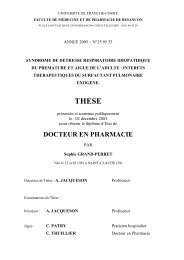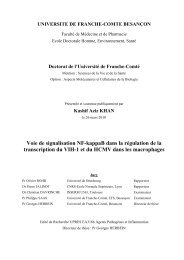THÈSE - Université de Franche-Comté
THÈSE - Université de Franche-Comté
THÈSE - Université de Franche-Comté
Create successful ePaper yourself
Turn your PDF publications into a flip-book with our unique Google optimized e-Paper software.
terrestris and T. europaea relative abundance changes were monitored on these parcels<br />
between 2001 and 2004, inclusive. Relative abundance was estimated in early spring.<br />
A questionnaire on ploughing practices in each parcel over the ten previous years (from 1992<br />
to 2002) and for the last three years for the other variables, was given to farmers in 2003. A<br />
multivariate analysis of the raw data led to the selection of 13 synthetic variables <strong>de</strong>scribing<br />
farming practices. The value kept for each variable was the data mean over the last three years<br />
(ten years for ploughing) (Table 1).<br />
High <strong>de</strong>nsity phase<br />
For communes characterised by a population <strong>de</strong>nsity score of 3, the effect of grazing and of<br />
soil disturbance was specifically investigated. Groups of three parcels were selected to<br />
investigate either grass or soil disturbances (Table 2). Information was recor<strong>de</strong>d from farmers<br />
for the year of study (2003). For each group, two levels of disturbances and a control parcel<br />
were selected in the same area and in the same landscape context. Thirty groups were selected<br />
for grazing types and 18 for soil work. The area of each parcel was 10 ha on average.<br />
Relative abundance of A. terrestris and T. europaea was recor<strong>de</strong>d as before in autumn 2003.<br />
DATA ANALYSIS<br />
At the beginning of the cycle, the population dynamic of A. terrestris was characterised in<br />
each parcel based on the spring data for the relative abundance over time. Relative abundance<br />
from 2001 to the year of maximal value was the only ones consi<strong>de</strong>red in this first step of the<br />
analysis in or<strong>de</strong>r to study the increase phase of the A. terrestris cycle. Two variables<br />
(maximum and <strong>de</strong>lay) were then kept for further analysis. The maximum being the maximum<br />
abundance value reached for each parcel and the <strong>de</strong>lay being the time period (number of<br />
months) between the start of the population increase in each parcel and in the corresponding<br />
commune.<br />
A principal component analysis on centred and normalised variables was used to represent the<br />
correlation between farming practices variable and to select variables characterising the<br />
relationship between parcels and their respective population dynamics (Legendre & Legendre<br />
1998).<br />
Thèse C. Morilhat 2005 103









